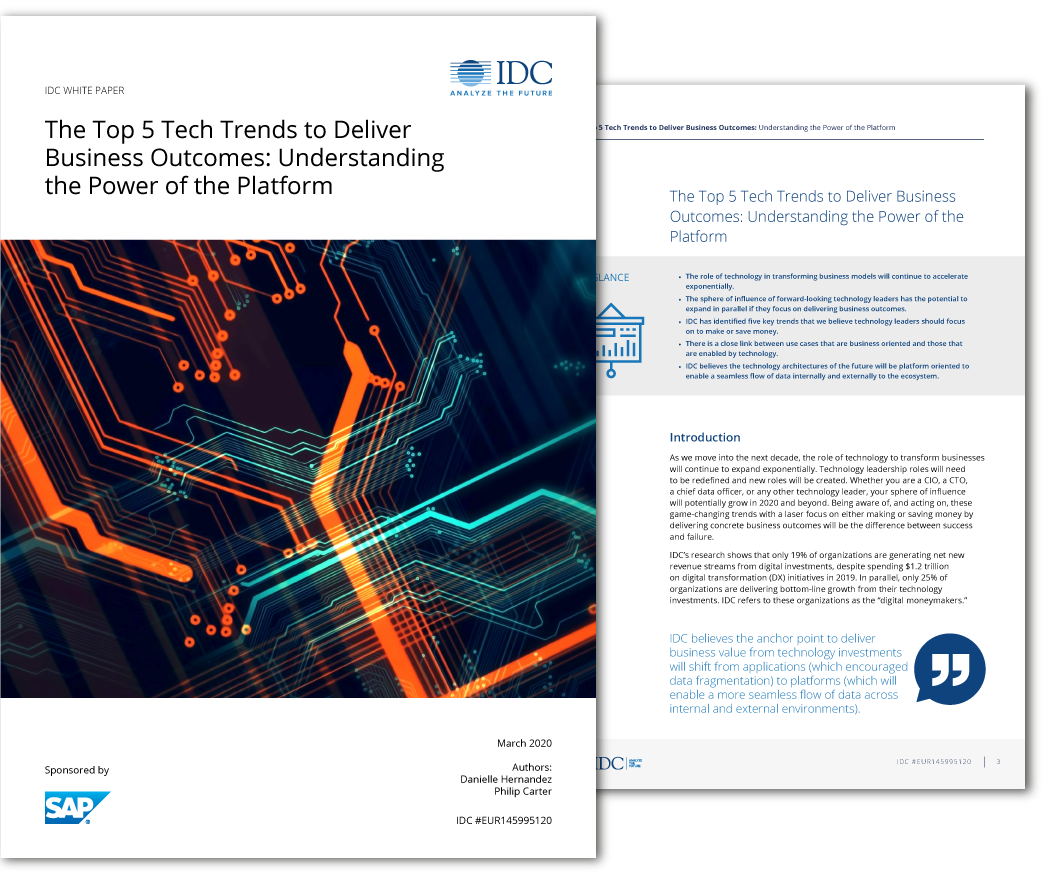Authors: Danielle Hernandez, Philip Carter
The Top 5 Tech Trends to Deliver Business Outcomes:
Understanding the Power of the Platform

At a Glance
- The role of technology in transforming business models will continue to accelerate exponentially.
- The sphere of influence of forward-looking technology leaders has the potential to expand in parallel if they focus on delivering business outcomes.
- IDC has identified five key trends that we believe technology leaders should focus on to make or save money.
- There is a close link between use cases that are business oriented and those that are enabled by technology.
- IDC believes the technology architectures of the future will be platform oriented to enable a seamless flow of data internally and externally to the ecosystem.
Introduction
As we move into the next decade, the role of technology to transform businesses will continue to expand exponentially. Technology leadership roles will need to be redefined and new roles will be created. Whether you are a CIO, a CTO, a chief data officer, or any other technology leader, your sphere of influence will potentially grow in 2020 and beyond. Being aware of, and acting on, these game-changing trends with a laser focus on either making or saving money by delivering concrete business outcomes will be the difference between success and failure.
IDC's research shows that only 19% of organizations are generating net new revenue streams from digital investments, despite spending $1.2 trillion on digital transformation (DX) initiatives in 2019. In parallel, only 25% of organizations are delivering bottom-line growth from their technology investments. IDC refers to these organizations as the "digital moneymakers."
IDC believes the anchor point to deliver business value from technology investments will shift from applications (which encouraged data fragmentation) to platforms (which will enable a more seamless flow of data across internal and external environments).

Why do These Trends Matter to Technology Leaders
As part of this, IDC believes a new technology architecture will be critical for organizations aiming to deliver business outcomes from their digital investments. The key to delivering business value will shift from applications (which encouraged data fragmentation) to platforms (which will enable a more seamless flow of data across internal and external environments).
The CIOs, CTOs, and chief data officers of the future will need to understand the potential of this approach to chart the next phase of their personal careers and take technology leadership to the board across all industries.
The White Paper showcases the five key trends and looks at the role this new platform architecture will play.
IDC research shows that only 19% of organizations are delivering net new revenue streams from digital investments and only 25% are reducing costs. These organizations are the moneymakers and money savers.

Conclusion: How the Digital Moneymakers Actually Deliver
IDC predicts that 75% of organizations will be digitally transformed over the next decade — and that the rest will fall out of business. The difference between the winners and losers will be an organization's ability to build out a data-driven, platform-enabled, and ecosystem-centric business model. To win this 10-year race to become a digital business, organizations need a new way of thinking, acting, measuring, and reporting success. The outcome will be a shift from traditional linear value chains to a model where all ecosystem interactions are part of a continuous feedback loop underpinned by a platform that enables the seamless flow of data across every single person and organization in the value chain.
This platform is a flexible application infrastructure architecture that enables the orchestration and automation of end-to-end business processes and the creation of a launchpad for business innovation capabilities.
This is done by leveraging the following key capabilities:
- Cross-silo analytics
- Intelligent technologies (such as AI, IoT, and intelligent RPA)
- Application development, integration, and extension
- Database and data management

The Top 5 Tech Trends to Deliver Business Outcomes: Understanding the Power of the Platform
Use the power of the platform to deliver business value
- Technology will continue to play an ever-greater role in transforming business models.
- Intelligent technologies (such as AI, IoT, and intelligent RPA)IDC believes that the technology architectures of the future will be platform-oriented to enable a seamless flow of data across your business ecosystem.
- Leaders will succeed by focusing on delivery of improved business outcomes.
- Technology-enabled use cases that are business-oriented are key to those outcomes.

About IDC
International Data Corporation (IDC) is the premier global provider of market intelligence, advisory services, and events for the information technology, telecommunications, and consumer technology markets. IDC helps IT professionals, business executives, and the investment community make fact-based decisions on technology purchases and business strategy. More than 1,100 IDC analysts provide global, regional, and local expertise on technology and industry opportunities and trends in over 110 countries worldwide. For 50 years, IDC has provided strategic insights to help our clients achieve their key business objectives. IDC is a subsidiary of IDG, the world's leading technology media, research, and events company.
5th Floor, Ealing Cross
85 Uxbridge Road
London
W5 5TH
44.20.8987.7100
Twitter: @IDC
idc-community.com
idc.com
5 Speen Street
Framingham, MA 01701
USA
508.872.8200
Copyright and Restrictions
External Publication of IDC Information and Data — Any IDC information that is to be used
in advertising, press releases, or promotional materials requires prior written approval from the appropriate IDC Vice President or Country Manager. A draft of the proposed document should accompany any such request. IDC reserves the right to deny approval of external usage for any reason.
Copyright © 2020. Reproduction without written permission is completely forbidden.
IDC #EUR145995120
A message from IDC

Please note that this White Paper was published before these challenging times became a reality across the global economy. However, the research, insights, and recommendations provided are all very much still valid. The imminent economic downturn globally will actually compel organizations to continue to invest in their digital initiatives — but the pressure on financial outcomes will increase. As part of this, IDC believes that technology will play a critical role in the recovery of the economy, as the pandemic has highlighted the potential of digital to multiply our value through intelligence, data, and a shift to platform-based business models.
As an IT executive, your sphere of influence will potentially grow in 2020 and beyond, but the new normal requires a new mindset. In case you are still wondering which areas of your business are ideal for adoption of disruptive technologies, we invite you to start asking different questions to uncover the potential value that digital initiatives can deliver. This will require an unwavering focus on the following:
- Establishing a future-proof technology architecture that underpins a business model that adapts and responds to uncertain external market pressures
- Creating a data strategy based on data pipelines feeding into and out of that integrated technology architecture
- Delivering digital innovation at scale so that new capabilities can be delivered in an unpredictable environment
- Modernizing core IT environments to establish the backbone for agile business models
- Developing a use-case journey that aligns the C-Suite to deliver on the ROI promise and deliver financial outcomes from digital
As these challenging times fundamentally shake up how we live, learn, socialize, and work, governments are taking drastic measures to keep citizens safe and healthy. IDC believes that the response of organizations in these uncertain times will shape the market perception of their brand in the next 10 years — technology leaders have a unique opportunity to define the future of business and society in a fundamentally positive fashion.



